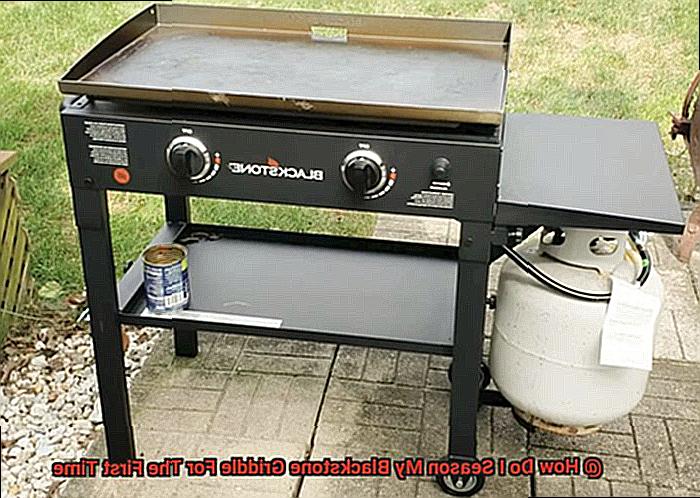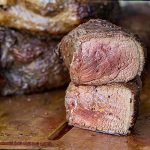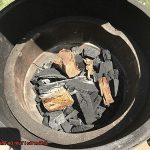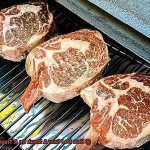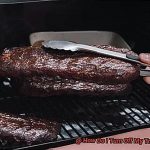Are you a grilling enthusiast eager to elevate your cooking game? Have you recently acquired a Blackstone griddle but are clueless about how to season it for the first time? Look no further. Seasoning your Blackstone griddle is an essential step towards achieving the best possible cooking experience on this robust and versatile surface.
A well-seasoned griddle not only prevents food from sticking but also ensures an even cook while preventing rust and other forms of damage. Though it may seem daunting initially, seasoning your Blackstone griddle is a breeze and can be accomplished in just a few simple steps.
In this blog post, we’ll guide you through everything you need to know about seasoning your Blackstone griddle for the first time. From prepping your griddle to distributing oil evenly and avoiding common mistakes, we’ve got you covered. Additionally, we’ll share some pro-tips for maintaining your griddle’s seasoning and keeping it in excellent condition.
So, grab your Blackstone griddle and let’s give it the seasoning treatment it deserves.
Contents
What is Griddle Seasoning?
If you own a Blackstone griddle, you know how important it is to keep it in tip-top shape. And one of the most essential steps in maintaining your griddle is seasoning it. But what exactly is griddle seasoning and why is it so important?
Griddle seasoning is the process of creating a non-stick surface on your griddle. This means applying oil to the cooking surface and heating it to a high temperature. The heat causes the oil to polymerize, creating a hard, non-stick surface that makes cooking and cleaning a breeze. The more times you season your griddle, the better the non-stick surface will be.
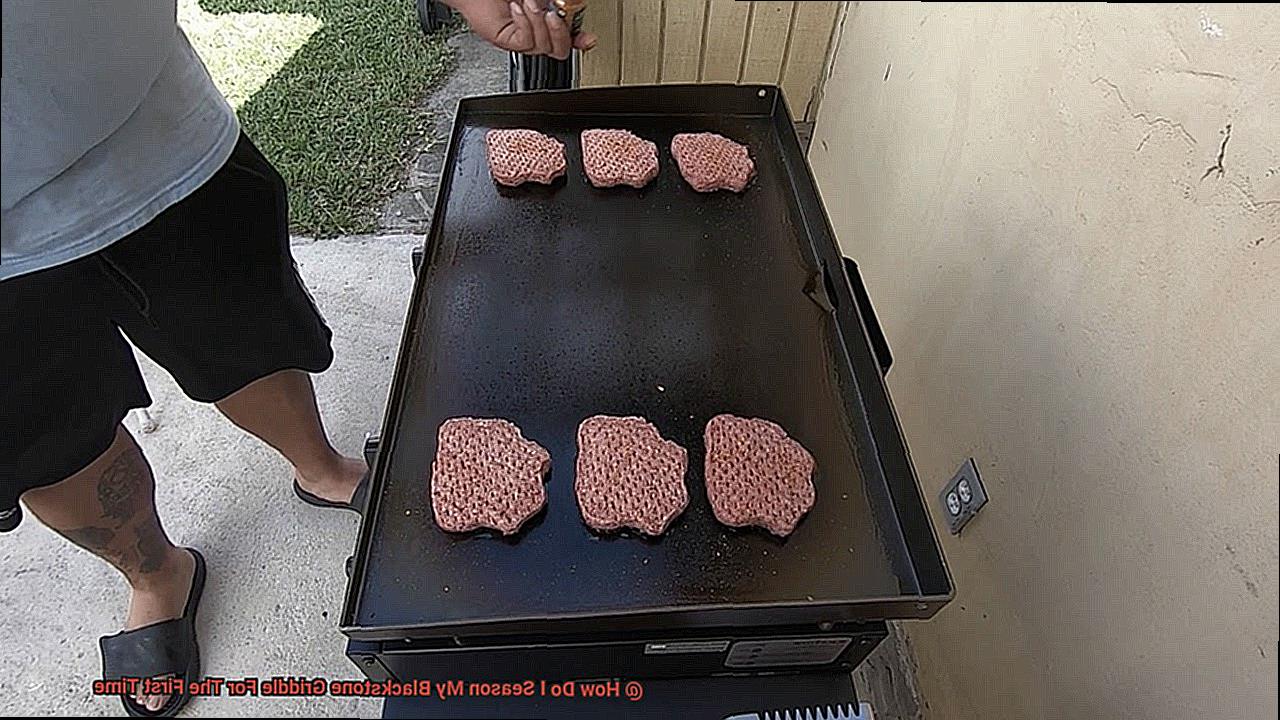
But not all oils are created equal when it comes to griddle seasoning. It’s best to avoid using vegetable oils like canola or soybean oil as they have a low smoke point and can leave a sticky residue on your griddle. Instead, use oils with a high smoke point like flaxseed oil, avocado oil, or grapeseed oil.
To start the seasoning process, make sure your griddle is thoroughly cleaned with soap and water. Once dry, apply a thin layer of oil evenly across the surface using a paper towel or cloth. Don’t forget to cover every inch of the griddle’s surface, including the sides and corners.
Next, turn on the griddle to high heat and let it heat up for about 10-15 minutes. This will allow the oil to bond with the griddle’s surface and create a non-stick coating. After heating, turn off the griddle and let it cool down completely before wiping off any excess oil with a paper towel or cloth.
It’s important to note that you will need to re-season your griddle periodically depending on how often you use it. And if you’re a cat owner, be mindful of what oils you use during the seasoning process as some oils may be toxic to cats.
Cleaning the Griddle
To ensure its longevity and optimal performance, cleaning it regularly is essential. Before you season it for the first time, it’s crucial to clean it thoroughly to remove any residue or debris left from manufacturing or shipping.
To begin, gather your supplies: a scraper or spatula, a bucket of hot soapy water, a sponge or rag, and a towel or paper towels. Here are the steps to follow:
Use a scraper or spatula to remove any large debris or residue from the griddle surface. Be gentle while doing this to avoid scratching the surface.
Fill a bucket with hot soapy water and use a sponge or rag to wipe down the entire surface of the griddle. Take your time and make sure you get all the nooks and crannies. You may need to rinse and wring out your sponge or rag several times during this process.
Once you’ve wiped down the entire surface of the griddle, it’s time to dry it off completely. Use a dry towel or some paper towels and make sure there is no moisture left on the surface before proceeding to the seasoning process.
By cleaning your Blackstone griddle thoroughly before seasoning it, you’ll ensure that any unwanted residue or debris is removed, resulting in better seasoning results and improved performance.
Remember these tips for maintaining your griddle’s cleanliness:
- Clean your griddle after each use.
- Use a scraper or spatula to remove any food debris while the griddle is still hot.
- Wipe down with hot soapy water and dry off completely after cleaning.
- Avoid using abrasive cleaners that can scratch the surface.
- Consider investing in a cleaning kit specifically designed for Blackstone griddles.
Choosing the Right Oil
When it comes to seasoning your Blackstone griddle, choosing the right oil is crucial. Not only does it affect the quality of your seasoning, but it also impacts the taste of your food. As an expert on this topic, let me guide you through the process.
The first rule of thumb is to go for an oil with a high smoke point. This means it can handle high temperatures without smoking or burning, resulting in a clean and durable seasoning. Flaxseed, vegetable, canola, and grapeseed oils are all excellent choices that can withstand the heat of your Blackstone griddle.
On the other hand, oils with low smoke points like olive oil or butter should be avoided at all costs. Not only will they burn and create a sticky mess on your griddle surface, but they can also leave an unpleasant taste in your food. Likewise, steer clear of flavored oils or those with added ingredients that can affect the quality of your seasoning.
To ensure you get the best results, always read the label carefully and check the smoke point when selecting your oil. And remember to use a fresh bottle of oil that hasn’t been sitting in your pantry for too long. Rancid oil can lead to poor quality seasoning and spoil the taste of your food.
Applying the Oil
Then let’s get started by discussing the crucial step of applying oil to your griddle for the first time.
Firstly, it’s essential to prepare your griddle surface. Give it a good scrub with soap and water, then dry it completely with a towel or paper towel. Remember, a clean griddle is a happy griddle.
Now, select an oil with a high smoke point. Some excellent choices are vegetable oil, canola oil, or flaxseed oil. Pour a small amount of oil onto the griddle surface and use a paper towel or cloth to spread it evenly across the entire surface, including the edges.
It’s important to avoid using too much oil as this can cause a sticky mess. Instead, aim for a thin layer of oil that will bond with the metal and form a protective layer.
Once you’ve applied the oil, turn up the heat to medium-high and wait until smoke starts to appear. This indicates that the oil has reached its smoking point and is bonding with the metal. Watch as your griddle transforms into a seasoned superstar.
After a few minutes of heating, turn off the heat and let your griddle cool down completely. Once it’s cool, wipe away any excess oil with a paper towel or cloth.
Repeat this process several times until you’ve built up a solid layer of seasoning on your griddle. Don’t be afraid to repeat this process until you’re satisfied that your griddle is well-seasoned. Remember, building up a solid layer of seasoning is key to maintaining a non-stick surface and preventing rusting.
Heating the Griddle
If you’re a fan of cooking on a Blackstone griddle, you know that seasoning it is essential to ensuring delicious, non-stick results. But before you can start seasoning your griddle, there’s an important step you can’t skip: heating it up properly.
Why is proper heating so crucial? For one, it removes any debris or rust on the surface. But even more importantly, it opens up the pores of the metal. This allows the oil to penetrate better and create a smooth, non-stick surface that will make cooking a breeze.
So, how do you go about heating your Blackstone griddle properly? The process is quite simple: turn on all the burners to high and let them heat for 15-20 minutes. This will remove any impurities and prepare the surface for seasoning. Once you’re done, turn off the burners and let the griddle cool down until it’s warm enough to touch.
But, as with any cooking method, there are a few things to keep in mind when heating your griddle. First and foremost: don’t overdo it. Heating your griddle too high can cause warping or damage to the surface. To avoid this, make sure you only heat it to a maximum temperature of 500°F.
Another important tip is to avoid using metal utensils on the griddle surface. These can cause scratches or damage to the seasoning, which can affect your cooking results down the line.
Letting it Cool Down
Let’s explore the significance of letting your Blackstone griddle cool down and how to properly care for it.
Firstly, allowing your griddle to cool down completely after use is vital because it allows the oils and fats to settle into the surface of the griddle, creating a non-stick surface that makes cooking a breeze. So, resist the temptation to clean or season your griddle immediately after use and let it cool down naturally to ensure the seasoning process works effectively.
Once your griddle has cooled down, it’s time to clean it. Use a scraper or spatula to remove any remaining food particles or debris from the surface of the griddle. Never attempt to clean your griddle while it’s still hot as this can cause burns or damage to the griddle. You can also wipe down the surface with a damp cloth or paper towel to remove excess grease or oil.
After cleaning, it’s crucial to reapply a thin layer of oil to the surface of the griddle. This helps protect the surface from rust and corrosion and maintains its non-stick properties. You can use any high smoke point oil like vegetable oil, canola oil, or flaxseed oil.
To summarize, letting your Blackstone griddle cool down after cooking on it is an essential step in maintaining a non-stick surface that will make cooking an enjoyable experience. Here are some key takeaways:
- Always let your griddle cool down completely before cleaning or seasoning it.
- Use a scraper or spatula to remove any remaining food particles or debris from the surface of the griddle.
- Wipe down the surface with a damp cloth or paper towel to remove excess grease or oil.
- Reapply a thin layer of oil to the surface of the griddle after cleaning to protect it from rust and corrosion and maintain its non-stick properties.
Wiping Off Excess Oil
If so, then let’s dive into why wiping off excess oil is an essential step in the seasoning process.
When it comes to seasoning your Blackstone griddle, applying a layer of oil is necessary to create a non-stick surface; however, leaving excess oil can lead to a sticky and gummy surface that will ruin your food. To avoid this, you must wipe off any excess oil from the surface.
Here’s how to do it:
- Step 1: After applying a layer of high-heat oil like vegetable or canola oil, grab a clean and dry cloth or paper towel.
- Step 2: Wipe off any visible layer of oil on the surface without wiping away the oil entirely. The goal is to leave a thin and even layer of oil on the surface that will help create a non-stick surface.
- Step 3: It’s crucial to note that you should wipe off excess oil immediately after applying it to the griddle surface. Waiting too long can result in the oil drying up and becoming challenging to remove.
- Step 4: Once you have wiped off the excess oil, turn on your griddle and heat it up to high temperature for 15-20 minutes. This will help bake the remaining layer of oil onto the surface, creating a protective layer that will prevent rust and make cleaning easier.
By following these simple steps, you ensure that you create a non-stick surface while preventing any sticky residue from ruining your food. Don’t forget to wipe off excess oil immediately after application and follow up by heating up your Blackstone griddle to ensure proper seasoning.
Re-Seasoning Periodically
If you want to keep your griddle’s non-stick surface in top condition, re-seasoning it periodically is essential. Over time, oils and fats used during cooking can build up and cause the griddle to become sticky, affecting the quality of your food. But fear not, because with a few simple steps, you can maintain your griddle’s effectiveness and enjoy delectable meals for years to come.
Firstly, it’s crucial to clean your Blackstone griddle thoroughly with soap and water, ensuring that all food debris and residue are removed. Once cleaned, turn up the heat to high and let it heat up for 10-15 minutes.
Next up, apply a thin layer of oil evenly over the surface of the griddle. Use a paper towel or brush and opt for an oil with a high smoke point like vegetable oil or canola oil.
Now comes the fun part – let the oil cook on the griddle for 30-60 minutes until it begins to smoke and darken in color. This process creates a new layer of seasoning on your griddle that enhances its non-stick properties and keeps it in top condition.
Remember to repeat this process every few months or as needed to ensure that your Blackstone griddle remains effective in providing scrumptious meals. Additionally, avoid using metal utensils or harsh detergents that may scratch or damage the surface.
Conclusion
In conclusion, seasoning your Blackstone griddle is a crucial step in unlocking its full potential for an exceptional cooking experience. By following a few simple steps, you can create a non-stick surface that prevents food from sticking and ensures an even cook while preventing rust and other forms of damage. Choosing the right oil with a high smoke point, applying it evenly, and wiping off excess oil are all essential parts of the seasoning process.
Maintaining your griddle’s cleanliness is key to keeping it in top shape. Cleaning it after each use, using a scraper or spatula to remove any food debris while the griddle is still hot, and avoiding abrasive cleaners that can scratch the surface are vital practices to follow. Properly heating your griddle before seasoning is important too since it removes any debris or rust on the surface and opens up the pores of the metal for better oil penetration.
Periodically re-seasoning your griddle ensures that its non-stick properties remain effective for years to come. With these tips for seasoning and maintaining your Blackstone griddle, you’ll be able to elevate your cooking game and enjoy delectable meals every time you use it.

